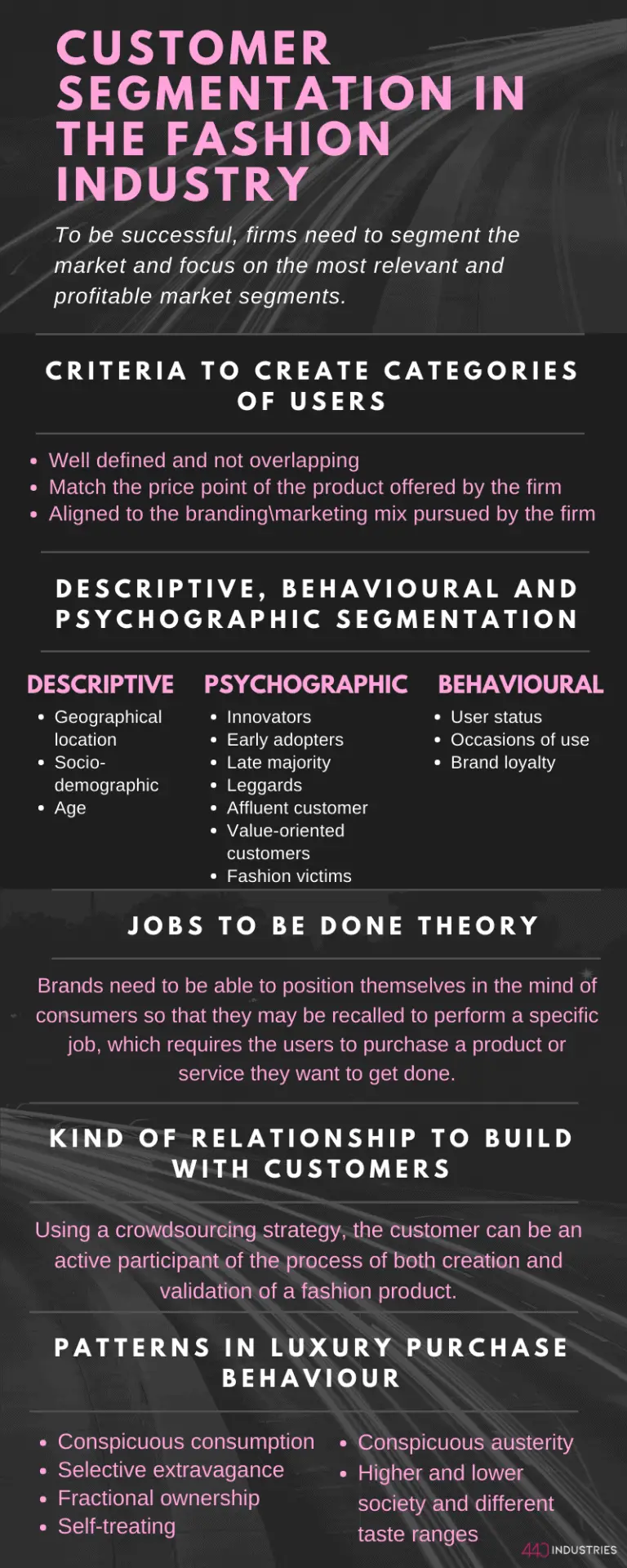Introduction
As companies develop their branding strategies, they are required to answer a fundamental question: who are their customers?
Without being able to identify who your brand is talking to, it is very hard to develop a marketing mix which will provide value to your target market.
Segmentation is the process whereby companies realise that they cannot be everything to everyone. In order to be successful and to rise above the noise, firms need to segment the market and focus on the most relevant and profitable market segments. Segmentation is a very challenging process, as it requires companies to process a high volume of heterogeneous information pertaining to both internal and external firm factors.
Companies rely on a variety of criteria to create custom types and categories of users which need to be:
- Well defined and not overlapping
- Match the price point of the product offered by the firm
- Aligned to the brandingmarketing mix pursued by the firm
On another level, once, the segments have been identified, firms are required to understand what are the behavioural patterns which are associated with a particular customer type. To answer this second question we will look into an innovative marketing theory called ‘Jobs to Be Done‘.
In this post we are going to analyse:
- Descriptive, behavioural and psychographic segmentation
- Alternative theories on segmentation: Jobs To Be Done theory
- New drivers in connecting to a firm’s audience: sharing and co-creation
- Consumer behaviour and luxury
- Conclusions
1. Descriptive, behavioural and psychographic segmentation
The first and most immediate approach we can pursue in segmenting a firm’s audience starts with creating groups of users which are defined by descriptive criteria such as:
- Geographical location. According to their area of residence, customers share particular characteristics, which are a reflection of the cultural and geographical area of residence. This segmentation starts from the fundamental assumption that individual behaviour and purchase preferences are influenced by factors (such as climate and culture) which can be segmented according to their geographical location.
- Socio-demographic. This criterion divides consumers on the grounds of elements such as income, age, gender, family status and life cycle stage. These factors require companies to match their product lines to particular price-points and product uses in order to become appealing to a specific customer segment.
- Age. Age is a very important element to create customer segments. Age relates specifically to the events which took place in the formative years of a generation. At the moment, we tend to identify the following age groups: pre-teens, millennials, generation X, baby boomers, new seniors. This latter category is fairly new and relates to the increase in life expectancy.
Alternatively, segmentation can decide not to focus specifically on the individual as a person, as much as an individual as a consumer. In this case, we need to understand elements which are more behavioural. In other words, we need to clarify not who heshe is, as much as what makes his purchase. This typology of segmentation is much harder to carry out, as we need to understand behavioural patterns and relationships of causality.
Behavioural segments instead relate to:
- User status. Users can be classified into non-users, potential users, habitual users, former users. In order to ‘speak’ to each, a company needs to use a different communicative approach. It can be noted that when we use the expression ‘disruptive innovation’ we refer to technological breakthroughs which are able to transform non-users into users, because of the lower price point that technological innovations are able to bring to the market.
- Occasions of use. This segmentation criterion relates to the context in which customers may buy a particular product or service because of a specific circumstance or in a particular situation or context. Some brands may decide to focus their marketing campaigns on connecting their products to a particular use rather than a set of unique product qualities.
- Brand loyalty. A loyal customer is someone will have grown a strong emotional attachment to the brand and will, therefore, become a returning customer by purchasing multiple times. A loyal customer has a very high lifetime value and brands need to make sure they retain this category of consumers as they are very profitable.
Understanding behaviour is an essential component to deliver an effective branding experience. This approach is also encouraged by Jobs to Be Done Theory and will be discussed in the next section of this post.
Finally, the last category of segmentation criteria is called psychographic segmentation. This segmentation relates to how a purchase decision is a reflection of an inner concept of self. According to how a customer reacts to change and innovation we can create the following categories:
- Innovators. This category of users will be very responsive to innovation and change. They will be the first to buy, to stay ahead of the curve and influence later consumers by providing feedback and reviews.
- Early adopters. This category of buyers will be the first to follow a trend as soon as it takes shape. These adapters will influence a product’s success the most as they will be the pathway to major adoption. This category of users can also be identified with the term ‘lead user’ to indicate those individuals who might fully appreciate the impact of a new product category. Firms often want to tap into lead users’ expectations and feedback to gain insights into how products can be developed.
- Late majority. The late majority of the target market is comprised of those individuals who will follow a trend as soon as it becomes sufficiently influential. With this category of users, a product reaches its peak of profitability but also starts its decline stage.
- Leggards. These users will adopt a product only because it will have become so widespread that is availability will influence their decision-making process.
An additional psychographic segmentation can respond to a customer’s ability to spend, according to the following characteristics:
- Affluent customers. Have enough resources to consider pricing just one of the variables that inform their purchase decision process. These customers, on the other hand, tend to be very considerate of their own time, so the quality of customer service is extremely important.
- Value-oriented customers. This category of customers tends to maximise the benefits of their purchase while maintaining a lower cost threshold. These customers will respond well to promotions and sales or another time-sensitive marketing strategy to ignite their desire to strike a bargain.
- Fashion victims. In this case, customers spend money, regardless of what they can really afford. These customers consider fashion products as an expression of their own personality, so they will be often over-driven by their emotions, rather than any degree of rational thinking.
Because of the increasing relevance of consumer behaviour, a new strand in marketing research was developed to focus on the relationship of causality that pushes the consumer to buy products and services. This approach is called “Jobs to Be Done”, and will be discussed in the following section of this post.
2. Alternative theories in segmentation: Jobs To Be Done theory
Jobs to be done theory is a marketing approach that allows firms to identify causal elements that are strictly connected with a purchase decision. This approach was designed to allow companies not to focus exclusively on descriptive elements but to dive deeper into the motivations that push consumers to buy.
According to this approach, brands need to be able to position themselves in the mind of consumers, so that they may be recalled to perform a specific job, which requires the users to purchase a product or service they want to get done.
Certain brands, like IKEA, are very effectively positioned in the market, not because of the particular features and qualities of their products, but because they are the perceived as the perfect means to satisfy certain jobs customers need to get done – like furnishing a students’ apartment.
According to this theory, some of the descriptive elements which are derived from traditional segmentation approaches, lead only to creating ‘personas’ or consumer types that would be the ideal customers of our company. This approach may be useful to clarify in what direction we want our brand to go, but it cannot really unearth the motivations that push himher to buy, or in other words what is the Job to Be Done.
Jobs to Be Done is a fringe theory, but it is gaining momentum, as it forces firms to understand what customers are really buying, which may not necessarily be what companies think they are selling them. If you’d like to look more into this theory, in this post we talk in more depth about it: Why Jobs to Be Done Matters for Your Business.
3. New drivers in connecting to a firm’s audience: sharing and co-creation
To some extent, as we identify who are our customers and why they buy our products, we need to understand what kind of relationship to build with them.
In the past, the relationship with customers was much more hierarchical, meaning that customers could decide whether to buy or not to buy our products, but could not partake in the value creation process.
In recent years, thanks to the development of digital technologies, the relationship between firms and customers has now completely changed, making the customer an active participant of the process of both creation and validation of a fashion product. This can be done through a crowdsourcing strategy, a marketing strategy design to create and make us of the community rallied around a brand to inform and develop design and marketing strategies for a product, or a product line. We address this topic in more detail in this article: Use the Crowd to Push Your Business.
Online digital platforms have in fact allowed organisations to involve in a very profound way their audience by creating new dynamic partnerships with their community and creating completely new marketing and communication strategies based on new dimensions of ownership, as shown by the share-economy platforms. One of the most famous examples of how a company can leverage its community is provided by Threadless.com which innovated the apparel design business from its foundations.
Firms are finding in this re-structured relationship with their target market the means to develop new business models, which thrive on the involvement of customers in a variety of processes such as garment design, creation, purchase and post-purchase experience.
4. Customer behaviour in luxury
Now that we’ve mastered both segmentation criteria and consumer buying behaviour, let’s address an additional challenge: understanding purchase behaviour in luxury. This is an essential goal for any company wishing to develop a competitive advantage either in their domestic market or internationally.
The general principles driving a customer to purchase luxury goods are either hetero-referred or self-referred. In case of the former, a customer is persuaded to buy luxury goods because heshe wants to feel a sense of belonging to a group, in case of the latter, the benefit of the purchase is either recreational or hedonistic.
Nonetheless, identifying patterns in luxury purchase behaviour leads to additional 6 segmentation criteria. Let’s look at each to understand what motives apply to luxury good consumers.
- Conspicuous consumption. According to this luxury purchase driver, consumers ‘spend to impress’, either to remark their exclusive lifestyle or to follow high-end trends. This is how most of us think about luxury good consumption.
- Selective extravagance. According to this luxury purchase driver, consumers decide to either trade up or trade down their shopping needs to make sure they are able to acquire high-end product in selected categories, at the expense of saving resources on many other accounts. These are the so-called ‘rocketing consumers’ which created the mix-and-match fashion style by combining luxury items with mass-market items.
- Fractional ownership. Luxury access according to this driver of luxury consumption is linked to share economies, where – to some extent – luxury is made more accessible as it becomes democratised. This is a growing segment, as many companies are now focusing on bringing down to the average customer level products which would otherwise be out of hisher league. This process is what is at the heart of disruptive innovation. To read more about this topic here is a dedicated article: “The 4 Types of Innovation You Need to Know About”.
- Self-treating. This driver relates to users who purchase luxury items for the intangible emotional benefits that they get out of acquiring something of high quality and high status.
- Conspicuous austerity. This driver of luxury purchase consists of spending large sums to purchase understating looks, which don’t give away their price point or status.
- Higher and lower society and different taste ranges. This driver of luxury acquisition suggests that high-society individuals have a much broader range of tastes, whereby lower-class individuals tend to focus on more narrow choices when it comes to taste.
How to manage such a wide variety of customer segments? As we’ll see in the conclusions paragraph, companies need to equip themselves with new technological infrastructures to capture their consumer value and retain it.
5. Conclusions
As discussed in this article, understanding who are your customers is important, but understanding why they buy your products is even more important.
In this sense, companies are now forced to delve much deeper into their target market to inform their management and marketing strategies. Only by segmenting their customer base, firms are able to gain a stronger understanding of what products they need to develop, and how they need to market them.
However, in order to build customer segments, we need data and in order to collect data, we need to create an IT infrastructure capable of assisting a firm in managing the relationships which are created with their customers.
In order to pursue a highly-targeted marketing strategy, a company needs to adopt new tools. This is why Customer Relationship Management (CRM) software has become an increasingly relevant tool to allow companies to ignite, support, convert and retain customers.
As fashion brands invest a high volume of resources to acquire customers, CRM software allows companies to manage customer relationships and maintain customer loyalty over time.
Once the marketing segmentation has been completed, firms are able to pick the most relevant customer segments and the particular need they want to address. This is at the ground of their branding positioning strategy, which will be discussed in our next instalment: Branding Decisions in the Fashion Industry.
If you’re interested in learning more about the Fashion Industry, don’t hesitate to take a look at our course “The Fashion Industry: Explained”. Our in-depth class covers a wide range of topics spanning from understanding fashion customers and markets to developing immersive retail experiences for your customers. Here’s a link to the course, if you use the discount code BLOG20 you can access a 20% discount. Enjoy!








